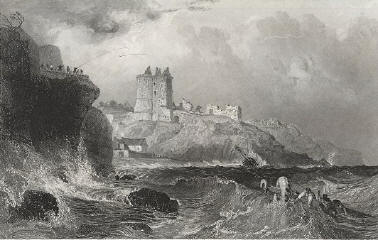|
Andrew Spratt
contributes:
On a rocky 100ft
cliff promontory between the Fife towns of Kirkcaldy and Dysart stands the
impressive double towered royal ruin of Ravenscraig castle, planned by
King James II of Scots (1437-1460) on land originally held by the Ramsay
family. On three sides it was protected by the sea, while on the landward
side there was a great dry ditch, now partly infilled giving a false
impression of the original defenses. The name Ravenscraig appears to
relate to the rock crag or craig where ravens gathered hence
'Ravens-Craig' and as a name seems to pre-date the construction of the
castle.
Originally the two D-plan towers, one on the east side and one to the west
were linked by a machicolated battlement wall above the main entrance,
which was accessed by a simple wooden bridge. What is strange about this
design is the west tower is some three levels higher than the east tower,
which sat level with the machicolated battlement, although two of its
vaults were below the inner courtyard level. The courtyard behind the
towers was enclosed by a low wall since it was protected by the sea,
though an oblong tower house possibly a kitchen and storage area was
perched on the far south end of the court but this may have been a later
addition to the plan.
The present ruin dates almost entirely from the 1460/63 period which is
very surprising as in addition to its traditional arrow slit gun loops of
a 1450's style (for breach loading weapons), it has several wide-mouthed
oval gun ports for small muzzle loading cannon which should technically be
of a 1500's date,(examples of such gun ports are found at Tantallon
castle in its outer spur work built between 1510/20). It is claimed that
Ravenscraig was one of the first castles in Scotland to be designed
specifically around the use of and defense against artillery. Certainly it
appears to have been highly advanced in its use of gunports and its tower
walls were almost 15ft thick, making them resistant to limited
bombardment.
The design origins of Ravenscraig appear to stem from King James II's
fascination with cannon. Sadly this fascination
resulted in his own death in 1460 during the siege of Roxburgh
castle, when one of his own guns the 'Lion' exploded tearing his leg off
and wounding his ally George the 'Red' Douglas of Tantallon castle.
Douglas was well enough several days later to crown the next King, James
III of Scots (1460-1488) at Kelso Abbey.
 Five
months before his death King James II arranged for Walter Ramsay to resign
his lands in Fife including Ravenscraig to Queen Mary of Gueldres. It
appears that "the building operations, began at the very
commencement of Mary's widowhood," and "were carried
out with great vigour under the direction of Master David Boys as Master
of Works." According to Queen Mary's accounts Boys received some £600
towards the building work which covered a wide range of items. Carts were
bought for transporting the stonework to Ravenscraig, even vast quantities
of oats were stockpiled. One report states "we have a large supply of
oats from Fife for horses transporting building stones to Ravenscraig."
A boat was also hired "to convey timber from Menteith to the
works there." In 1461 fourteen great timber joists were felled
from the banks of the river Allan then transported to Stirling at the cost
of 7 shillings. Andrew Balfour then received £2,10
shillings for cutting planning and transporting these
joists to Ravenscraig. After Mary’s death in 1463 work appears to have
stopped overnight with the upper levels of the towers incomplete. Five
months before his death King James II arranged for Walter Ramsay to resign
his lands in Fife including Ravenscraig to Queen Mary of Gueldres. It
appears that "the building operations, began at the very
commencement of Mary's widowhood," and "were carried
out with great vigour under the direction of Master David Boys as Master
of Works." According to Queen Mary's accounts Boys received some £600
towards the building work which covered a wide range of items. Carts were
bought for transporting the stonework to Ravenscraig, even vast quantities
of oats were stockpiled. One report states "we have a large supply of
oats from Fife for horses transporting building stones to Ravenscraig."
A boat was also hired "to convey timber from Menteith to the
works there." In 1461 fourteen great timber joists were felled
from the banks of the river Allan then transported to Stirling at the cost
of 7 shillings. Andrew Balfour then received £2,10
shillings for cutting planning and transporting these
joists to Ravenscraig. After Mary’s death in 1463 work appears to have
stopped overnight with the upper levels of the towers incomplete.
In 1470 King James III bestowed Ravenscraig to William Sinclair (St
Clair),4th Earl of Orkney, in exchange for his castle in Kirkwall
and "his haill right to the Earldom of Orkney." It was the
Sinclairs who added the high crowstepped gabled roofs to the D-plan towers
instead of completing these towers as cannon platforms which was probably
King James II's original intention. During the 1650's Ravenscraig, like so
many other Scottish castles suffered some damage as Oliver Cromwell's army
marched north into the highlands of Scotland. By the 1800's the castle
became used as a quarry and was stripped to build cottages and walls
locally.
|


